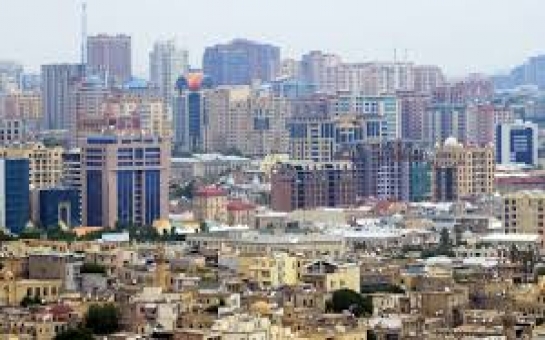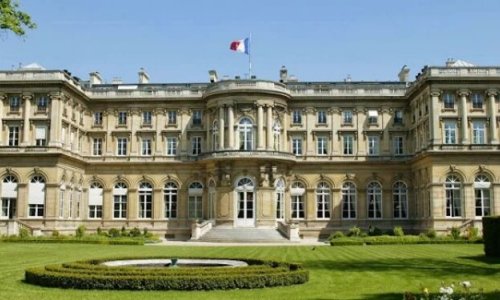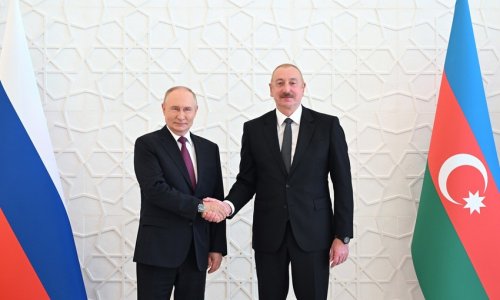Baku's newly opened Fairmont Hotel occupies one of three flame-shaped skyscrapers whose curved facades, come nightfall, transform into giant video screens depicting blazing fires. From the 27th floor, there’s a lovely view of the Azerbaijani capital and its crescent-shaped bay in the Caspian Sea. One evening, an employee joins me at a window near the elevator and directs my gaze to a 162-meter pole topped witha national flag the size of two tennis courts. With evident pride, she tells me it’s the tallest flagpole in the world. In 2010, Azerbaijani President Ilham Aliyev marked its unveiling with an elaborate ceremony featuring scores of goose-stepping soldiers.
The catch: Less than a year later, Tajikistan, another oil-rich ex–Soviet republic, unveiled its own record-breaking flagpole, 3 meters (10 feet) taller than Azerbaijan’s. For some reason -- likely related to this country’s notoriously tight control of its media -- word of Tajikistan’s one-upmanship hasn’t spread. My window mate isn’t the first to claim this record for her country, and she won’t be the last.
No matter. Baku has already moved on to bigger, better and more expensive and eye-catching trophies, as Bloomberg Pursuits reports in its Summer 2014 issue. Among them are a radically undulating arts center designed by Baghdad-born starchitect Zaha Hadid; a $640 million soccer stadium that will serve as the main arena for next year’s inaugural European Games; and, still on the drawing board, an archipelago of 50 fake islands with deluxe apartments for at least 400,000 people.
Since 2006, when the opening of the Baku-Tbilisi-Ceyhan pipeline prompted a surge in crude oil exports -- up to a million barrels a day travel through neighboring Georgia and on to Turkey and the West -- there’s been no shortage of cash in Baku. Now, the city is eager for the prestige that goes with it.
“Azerbaijan is trying very hard to make Baku a world-class destination,” says Sam Ioannidis, general manager of the city’s new 171-room Four Seasons, a châteaulike, nine-story limestone pile whose lobby columns are trimmed in 22-karat gold. Ioannidis acknowledges that the hotel, which is owned and financed by Azerbaijani investors, might seem “completely overbuilt” right now. But given Azerbaijan’s almost limitless ambitions, he says, “places like this set the tone for the rest of the country -- and for the future.”
If you’re not in the oil or gas business, or a follower of the Eurovision Song Contest, which this city hosted in 2012 after speed-building a purpose-made arena, it’s unlikely that Baku is top of mind. Despite a handful of recent news articles anointing it as the Caucasus’s answer to Dubai, Azerbaijan is not yet an established tourist destination, in part because of its draconian visa policy, which requires many foreigners to obtain an official invitation, usually from a hotel or registered Azerbaijani travel agent.
However, thanks to a rich cosmopolitan history that’s measured in millennia, Baku turns out to be a much more interesting place than the insta-cities of the Persian Gulf. Inside the ancient walls of Baku’s Unesco-listed historic core are caravansaries, mosques and restored medieval palaces, built when the city was a major stop on the Silk Road. The streets near the seaside are lined with elegant beaux-arts buildings and ostentatious mansions dating to Baku’s first energy boom, in the early 20th century, when oil barons such as the Nobel brothers and the Rothschilds made fortunes here. Azerbaijan was also the first secular democratic republic in the Muslim world and -- who knew? -- the first Muslim nation to grant voting rights to women, in 1918, two years ahead of the U.S.
In 1920, the Red Army rolled in, putting an end to the progressiveness and adding a layer of totalitarian inscrutability that’s still palpable in Baku’s East-West, socialist-capitalist, Muslim-secular, ancient-modern mishmash. For a visitor today, the city offers a nonstop barrage of unpredictably intriguing weirdness, beginning at the exit from the airport, where Baku’s London-style taxis, thousands of which were ordered by the government two years ago -- in purple -- await arriving passengers. During my ride into town, my driver’s only attempt at communication is his offer to pad my receipt in exchange for an extra 5 manat, or about $6.
Depending on which direction you look in central Baku, you might feel like you’re in East Berlin before the fall of the wall, present-day Las Vegas, tomorrow’s Istanbul or, well, you name it. Among the sights within a several-block stretch along the seaside promenade are a sublime, Soviet-era outdoor cafe, with a roof that resembles the shell of a giant clam; an Italian restaurant called Venezia, in a kitschy complex of fake mini canals replete with gondolas; the brand-new State Museum of Azerbaijan Carpet and Applied Art, designed in the shape of a rolled-up rug; and a greenhouse sheltering 200-year-old baobab trees imported from Argentina.
Across the street, adjacent to the ancient stone Maiden Tower (it dates to either the 5th or the 12th century; the museum’s signage concedes that nobody knows for sure), are a parade of boutiques by Céline, Gucci, Tom Ford, Valentino and other global luxury labels. Presiding over it all are the Flame Towers, where the fire videos alternate with moving images of 190-meter-tall men brandishing the Azerbaijani flag.
On one of my first nights in Baku, I join a convivial group of Azerbaijani businessmen and Cuba’s ambassador, Omar Medina Quintero, for their regular gathering at La Casa del Habano, a cigar lounge located off the fluorescent-lit lobby of the Days Hotel. Brandishing Cohibas and Davidoffs while sipping brandy and speaking in a mix of Azerbaijani, English and Russian, the men discuss Iran’s huge potential as an oil market, Baku’s ever-worsening traffic problem and the buzz about Azerbaijan’s upscale new ski resort, Shahdag, a couple of hours inland. Among privileged Bakuvians last winter, a Facebook selfie from the slopes of Shahdag was an absolute must. Adding spice to all the people watching is the frequent sight of dramatic pratfalls, since very few Azerbaijanis know how to ski.
Although many Baku residents profess equal degrees of excitement and wariness at the rapid pace of change, one thing you’ll rarely hear is open criticism of President Aliyev, whose authoritarianism and disregard for civil liberties have been widely chronicled outside the country. According to Human Rights Watch, a New York–based advocacy group, the government has a long record of persecuting journalists, repressing protests and improperly evicting thousands of residents in order to make room for all the new construction. Dissidents, journalists and many ordinary citizens take it for granted that their communications -- and even their most intimate activities -- could be under constant surveillance.
One morning, I sit down for tea with the director of Baku’s carpet museum, whose new rug-shaped headquarters was personally approved by President Aliyev. Roya Tahiyeva, a chic and lively 69-year-old, is wearing dark eyeliner and an all-black ensemble that includes a Donna Karan dress, Prada boots and a Marc Jacobs bag. Tahiyeva has been with the museum since the mid-1960s and recalls hosting Empress Farah of Iran at its previous, cramped location. She sees pros and cons in the speedy transformation of Baku but chooses to emphasize the pros. “Many cultural traditions in Azerbaijan are disappearing quickly,” she says, “which makes it even more important that museums like this are preserving them.”
Still, it’s clear that Baku’s main priority is not its past but its future, as epitomized by the high-tech voluptuousness of Hadid’s design for the new Heydar Aliyev Center, a testament to the power of a seemingly limitless budget. The 57,000-square-meter (614,000-square-foot) building is one of those rare architectural works that can change your view of what’s possible, with its succession of flowing, sinuous forms that fold in on themselves or burst into undulating, all-white volumes three stories high. Inside are several exhibition spaces, one of which recently housed “Fly to Baku,” a group show of contemporary Azerbaijani art organized by the noted French curator Hervé Mikaeloff. According to Mikaeloff, the arts in Azerbaijan are rapidly playing catch-up after decades of Soviet Realism, with a young generation that’s “now closer to European sensibility, doing installations and working in different media.”
There’s little doubt that colossal oil revenue, along with a deep craving for cultural legitimacy, are a boon to Baku’s creative community. At the headquarters of Yarat, a three-year-old arts organization founded by 32-year-old Aida Mahmudova, a niece of the president, I meet with an engaging group of young artists who’ve spent much of the past few years bouncing among art fairs and museum shows throughout the world. In addition to promoting local artists abroad, Mahmudova, a graduate of London’s Central Saint Martins College of Art and Design, says she aims to “nurture an understanding of contemporary art” in Baku through educational programs and a vast new exhibition space and library that are set to open next year. It seems to surprise no one that Mahmudova’s paintings, along with those of her cousin, First Daughter Leyla Aliyeva, are featured prominently in the collections of Baku’s Museum of Modern Art, as well as in the “Fly to Baku” exhibition.
Artist Farid Rasulov, who at 28 has already shown his work in two Venice Biennales, characterizes the current pace of change in his native city as both stupefying and inspiring. “You leave Baku for just three or four months, and you come back and see brand-new parks and buildings,” Rasulov says. “There’s a totally new rhythm here now, and it can motivate you to push yourself.” Still, in many of Rasulov’s artworks, a sense of ambivalence is unmistakable. His Architectural Dichotomy sculptures, for example, are amalgams of traditional shebeke-style stained glass and modern Baku’s most ubiquitous material: concrete. The shebeke -- geometric designs made without glue or nails -- often seem to be drowning in the concrete or on the verge of getting crushed under its weight.
A couple of blocks from Yarat is one of the city’s few remaining traditional Azerbaijani restaurants, the tiny, wood-paneled Tandir, with a clay oven in the middle of the entryway and several photos of a visiting Vladimir Putin on the wall. (In the aftermath of Russia’s recent incursion into Crimea, there have been no signs of pending aggression here, but the situation remains unpredictable, and many in Azerbaijan are watchful, particularly given Russia’s move into Georgia in 2008.)
Down the hill is one of Baku’s sleekest new retail temples, the three-floor concept store Emporium, next door to a Bentley dealership. Although the profitability of Baku’s new luxury boutiques is difficult to gauge -- sales staff invariably outnumber shoppers during my visit -- business at Bentley Baku, at least, seems to be just fine; last year, sales manager Hamid Hajiyev was named one of the carmaker’s top performers. Hajiyev tells me that the best-selling model is the largest: the Flying Spur, priced at about 220,000 euros ($300,000). “We’re a four-door market; people like things big here,” Hajiyev says with a smile. “And most every buyer wants the car fully loaded, with all the available options.”
After dark, Bentley owners and their hangers-on today have many more alternatives to the dive bars and hooker hangouts that Baku was long known for. Starting at dinnertime on weekends, the city’s upscale party crowd begins networking via Facebook, Instagram and WhatsApp to figure out which of the three current hot spots -- Eleven, Opera Sky and Pasifico -- will be the favored venue for the night. One Saturday, I stop by Eleven, on the penthouse floor of the 11-story Park Inn, as it fills with groups of men in T-shirts and blazers and gaggles of shapely women whose ultra-high heels and ultra-short skirts make it easy to forget this is a Muslim country. (Western-style dress is the norm for men and women throughout Baku, and alcohol is widely available.)
The music mix at Eleven is heavy on Beyoncé and mainstream Russian pop, and the lack of pretension is surprising, especially given that the tables closest to the deejay booth are permanently reserved for “super-VIPs,” at a rate of $2,600 a night. Orkhan Aghayev, the deejay and singer who runs the place, leaves his iPhone unattended on his table while he bounces around the club to schmooze. “We have 50 security cameras here,” he explains. “People know better than to try to steal it.”
Before leaving Azerbaijan, I’m eager to sample one of several possible side trips from Baku, most of which fall along a spectrum of strange to downright freakish. South of the city, for example, lies the world’s highest concentration of active mud volcanoes -- hundreds of mounds that gurgle with dark sludge and methane gas. Because of a snowstorm during my stay, the road to the volcanoes is in terrible shape, so I have to settle for my second choice: a mountain with flames shooting out of it.
Yanar Dag, reached via a road that passes fields jammed with oil derricks, is a natural-gas fire that’s been burning continuously for decades, allegedly since a shepherd sparked it with a discarded cigarette. Although the 9-meter row of flames bursting from a hillside is a fitting reminder of Azerbaijan’s vast energy reserves -- to say nothing of its millennia-long history of fire worship -- the tourist infrastructure, with its rickety wooden benches, has yet to be upgraded in accordance with Baku’s new five-star standards. The ticket taker is AWOL due to the lousy weather, and the Azerbaijani friend who’s brought me here has to beg the grumpy guard to let us in.
Meanwhile, back at Flame Towers, Baku’s more modern fire shrine, there are no visible signs of neglect. Come autumn, in addition to the Fairmont, the complex will house 69 floors of lavish apartments and offices and yet another new luxury mall.
(Christopher Bagley is a contributing writer for Bloomberg Pursuits. Opinions expressed are his own.)
Bakudaily.az











